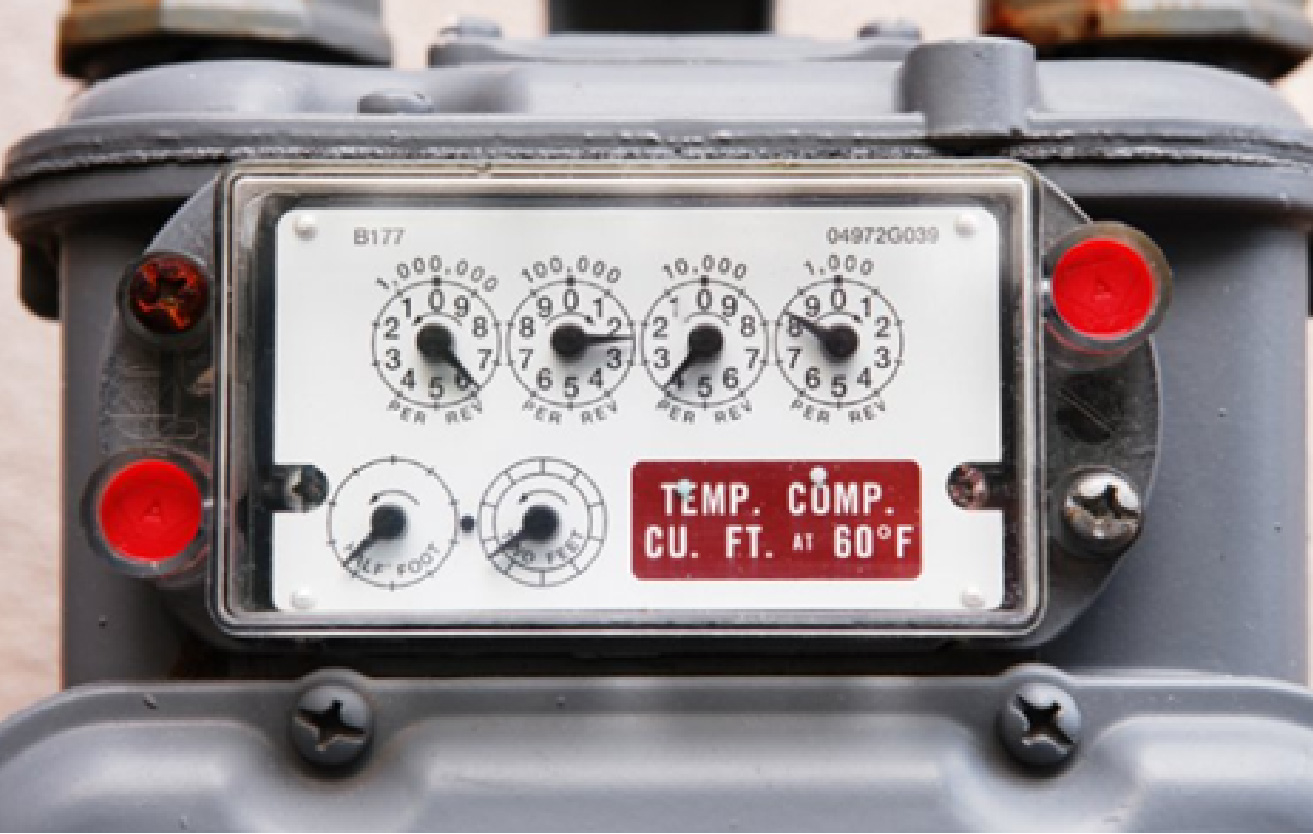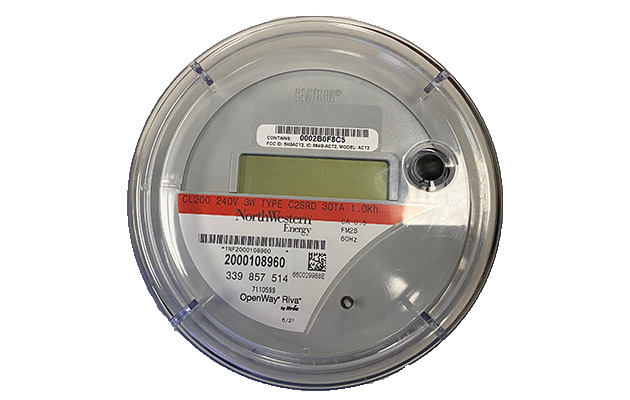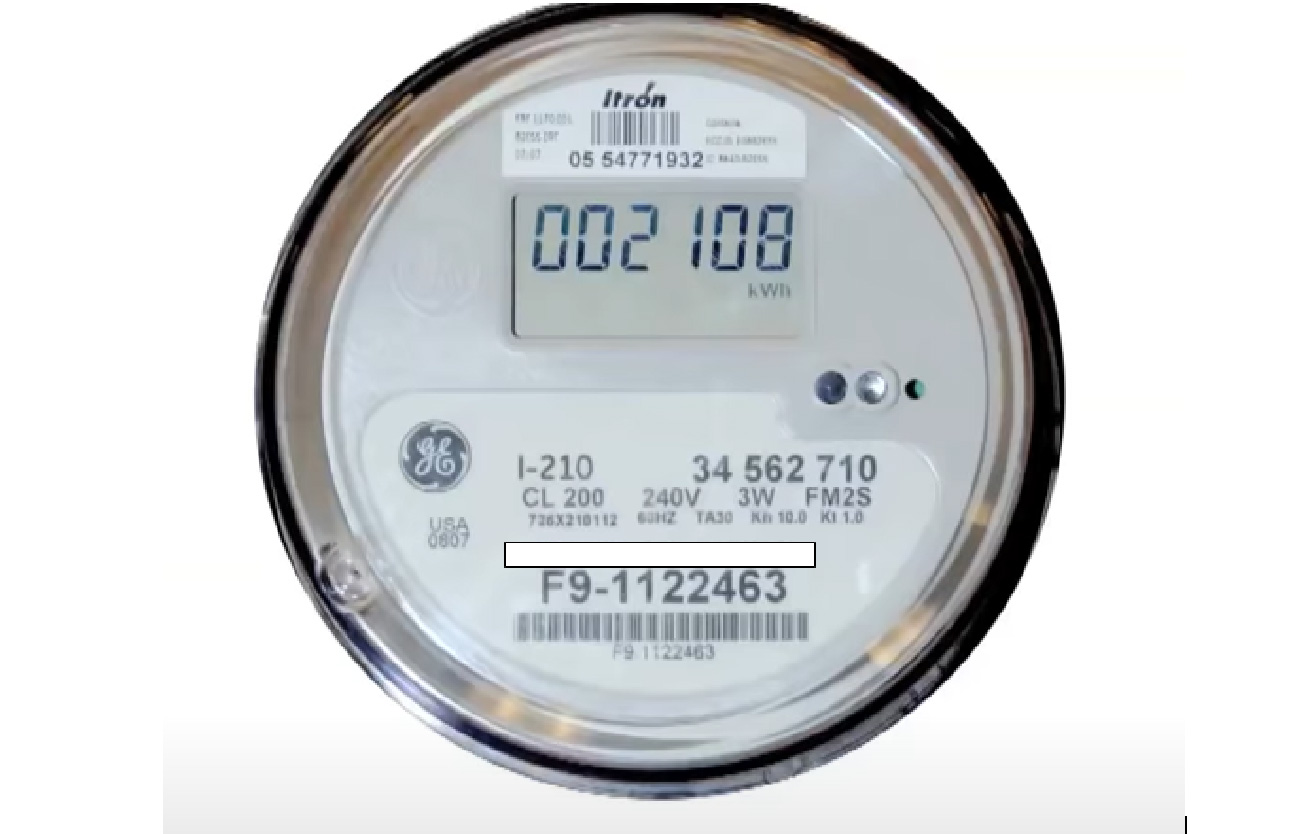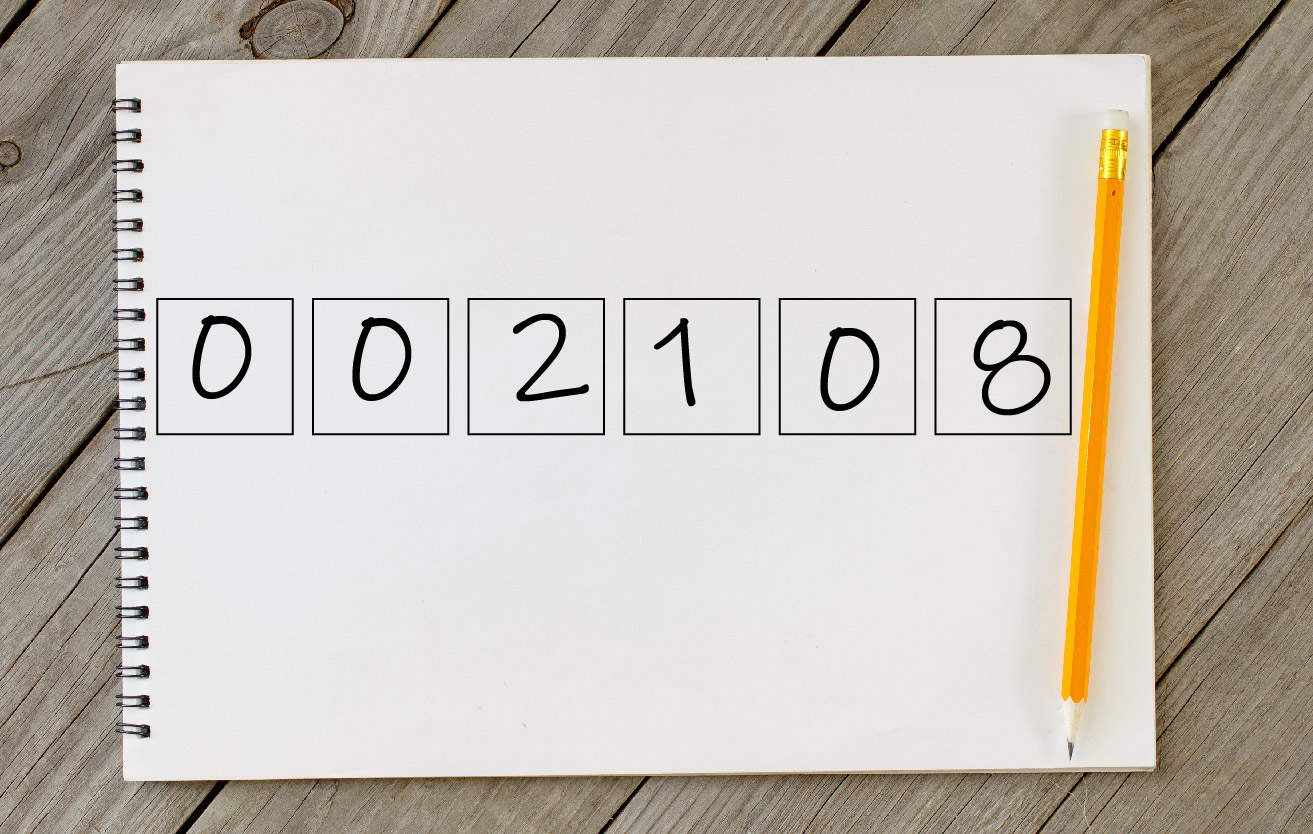Non-communicating meters
How do I read my non-communicating meter?
Click the links below for instructions on how to read your meter, self-read dates and a postcard you can use to submit your meter readings.
Gas meter

Gas meter
Natural gas dials represent the amount of natural gas measured in volumes of hundreds of cubic feet (ccf).
A gas meter is driven by the force of the moving gas in the pipe, and also turns faster as the flow increases. Each time the dial with the lower value makes one complete revolution, the pointer on the next higher value dial moves ahead one digit.
To read your meter:
- Be at eye level of the dials.
- Mark the dials from left to right.
- Take note of the direction of the arrows on the display – the pointer of adjacent dials turn in opposite directions to each other.
- Draw the pointer on the dials as displayed on your gas meter.
- When the pointer on the dial is between two numbers, record the lower number.
- If the pointer is between 9 and 0, 9 is the lower number.
- When the pointer is directly on the number, look at the dial to its right:
- Has the dial on the right has passed 0, yes, use the number that the pointer is on.
- The dial on the right has not passed "0," use the number less than what the pointer is on.
Example:
In the example below, the reading is: 6 2 3 8


Electric meter

Electric meter
The basic unit of measure of electric power is the watt. One thousand watts is called a kilowatt.
When you use one thousand watts of power in one hour, you have used one kilowatt (kWh).
We bill you by the kWh. Your electric meter is a digital meter that has an electronic display that displays the current reading, like a digital clock.
When reading an electric meter, write down the numbers as shown on the meter.
Example:
In the example below, the reading is: 0 0 2 1 0 8


When submitting your meter reads, please be ready with your account number, your service address, your meter read(s) and the date you read your meter(s).
Options to submit your meter reads:
- Submit online in My Energy Account
- Call (888) 467-2669; M-F 7 a.m.-6 p.m.
- Mail the meter reading card to us at:
Communicating meters
How do I read my communicating advanced meter?
Click the links below for instructions on how to read your meter, self-read dates and a postcard you can use to submit your meter readings.
Advanced Meter FAQs
What is the advanced meter project timeline in Montana?
NorthWestern Energy began installation in Montana in 2021. Here is a list of approximate dates for the Montana Meter Upgrade project by area:
- Missoula Division: completed August 2022
- Butte Division: completed June 2022
- Bozeman Division: completed May 2024
- Billings Division: completed October 2024
- Lewistown District: completed October 2024
- Havre District: completed November 2024
- Helena Division: June 2024 – May 2025
- Great Falls Division: August 2024 – May 2025
Will I have to pay for the meter?
Who will change my meter?
NorthWestern Energy contracted with Tru-Check to install the new digital meters, the same company that installed the first generation, one-way communication digital meters in 1998 that are in use today.
Tru-Check technicians will wear apparel with the Tru-Check logo and will carry a NorthWestern Energy contractor identification badge.
When will the meters be installed and do I need to be home?
Most of the installations will occur Monday through Friday during business hours, though there will be cases when evening or weekend installations may be necessary. Customers don't need to be home.
A door hanger will let residents know their upgrade was successful. If the technician cannot perform the upgrade, a door hanger will be left with instructions to call to make an appointment.
If you are both an electric and natural gas NorthWestern Energy customer, the new electric meter will be installed first and the new gas module will be installed during a follow-up visit to your home or business in about eight weeks.
What happens to the meter on my home or business now?
Are radio frequency (RF) emissions coming from the meters and modules?
Yes. The Federal Communications Commission (FCC) regulates the safety limits for all RF emissions, and smart meter and module emissions make up a small portion of the limit. The RF emissions of the one-way communication meters in use now and the two-way communication meters that are being installed for this technology upgrade are both approved by the FCC. Radio frequency emissions are also produced by common household devices such as microwaves, baby monitors and TVs.
Is customer information protected?
Yes. Customer privacy and security are NorthWestern Energy priorities. The company’s strict security standards have contributed to protecting the energy grid and customer privacy for years. The meters do not collect, store or transmit any personally identifiable information.
The meters measure total energy and cannot differentiate energy usage by appliance or anything else within a home or business. The transmitted energy use information is encrypted.What if I don’t want an upgraded meter?
Customers who want to keep their existing meters can call NorthWestern at 888-467-2669 or email NorthWesternEnergyMeters@northwestern.com to be added to the bypass list. Customers who previously requested an opt out do not need to contact NorthWestern again to be bypassed and keep their meters.
NorthWestern will be reaching out to customers who received an advanced meter despite their request to opt out. For those who still wish to opt-out, NorthWestern will ensure that the advanced meter is removed and replaced with a meter similar to the one that was there before. Customers will not be charged for this service.
Customers who have questions about the advanced meter opt-out program can contact NorthWestern at 888-467-2669
or the Montana Public Service Commission at 1-800-646-6150 or pschelp@mt.gov.

Facts are important when it comes to NorthWestern Energy’s Montana property taxes
Date: Sep 6, 2024
TYPE: News
By NorthWestern Energy President and Chief Executive Officer Brian Bird
Taxes.
Opinions about what’s fair, what’s affordable and what’s the wisest way to spend taxes are abundant. Opinions about whether some get a deal while others shoulder too much are plentiful.
Some statements being made this campaign season about NorthWestern Energy and Montana property taxes are flat out wrong and misleading.
It’s important to know the facts.
In Montana, NorthWestern Energy is the largest single property taxpayer in the state by a significant amount. Residential property taxpayers contribute the largest amount, as a group, of property taxes in Montana.
Property taxes are a flow through expense on NorthWestern Energy customer bills – which means if they go up, customer bills go up and if they go down, customer bills go down.
Fact
Montana property taxes are collected by NorthWestern Energy through customer bills for the state of Montana, schools, counties, cities and a variety of special districts.
Fact
Our state has a multi-class property tax system with different valuation methods and rates for each classification. For example, the taxes on Class 9 (pipelines and some electric utility property) are $6,000 for every $100,000 of property value calculated using 500 mills. Taxes on Class 5 (which includes rural electric and telephone cooperative property) is set at $1,500 for every $100,000 of property value calculated using 500 mills. For Class 4 (residential property) taxes are set at $675 for every $100,000 of property value calculated using 500 mills.
Fact
About two thirds of NorthWestern Energy’s Montana assets are Class 9, which means they are taxed at the highest rate of 12%.
Fact
Another third of our assets are Class 13 and are taxed at a 6% rate.
Fact
Businesses include their cost of property taxes in the price of their goods and services. NorthWestern Energy is more transparent.
Fact
More than 10% of NorthWestern Energy’s residential rates are due to Montana property taxes, which are flowed through to customer bills. That’s about $11.30 a month for our typical residential electric customer and about $5.89 a month for our typical residential natural gas customer.
Fact
NorthWestern Energy provides electric and natural gas in South Dakota and natural gas service in Nebraska.
By comparison to Montana, about 2.30% of NorthWestern Energy’s electric residential rates and 0.83% of residential natural gas rates in South Dakota are due to South Dakota property taxes. That’s about $2.59 and 33 cents a month, respectively, for our typical South Dakota residential electric and natural gas customer.
In Nebraska, 1.08 % of our residential natural gas rates are due to state property taxes, or about 46 cents a month for our typical residential customer.
Fact
If NorthWestern Energy’s Montana property tax liability decreases, which happened last year, customer rates lower, which they did Jan. 1, 2024. If NorthWestern Energy’s Montana property tax liability increases, customer rates increase. State property taxes are a flow through cost to customer bills.
Montana property taxes are a hurdle for NorthWestern Energy as we work to keep rates as affordable as possible for our Montana customers.
Montana is home for more than 1,200 of NorthWestern Energy’s employees who work and raise their families in the communities we serve. More than half of Montanans are NorthWestern Energy customers.
We want taxes to be fair and properly assessed.


